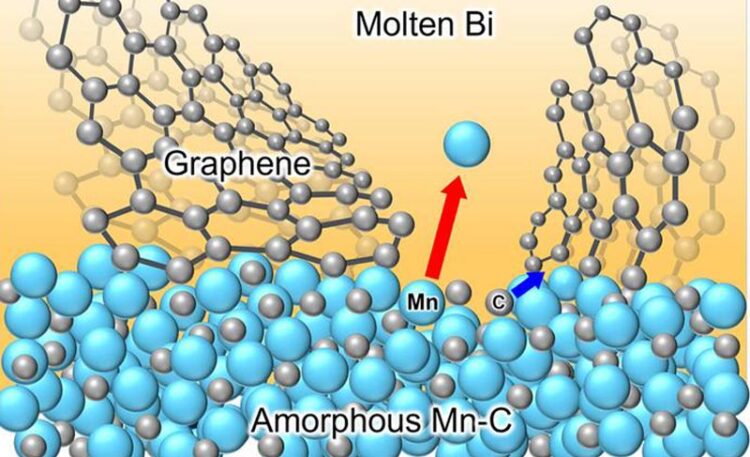Improving sodium ion batteries

Schematic illustration for the formation NCG during liquid metal dealloying of amorphous manganese-carbon (Mn-C) alloy in a molten bismuth (Bi) to induce selective dissolution of manganese (Mn) atoms and self-organization of carbon (C) atoms into graphene layers.
Credit: S.H. Joo & H. Kato
… with mechanically robust nanocellular graphene.
Ever since its discovery in 2004, graphene has been revolutionizing the field of materials science and beyond. Graphene comprises two-dimensional sheets of carbon atoms, bonded into a thin hexagonal shape with a thickness of one atom layer. This gives it remarkable physical and chemical properties. Despite its thinness, graphene is incredibly strong, lightweight, flexible, and transparent. It also exhibits extraordinary electrical and thermal conductivity, high surface area, and impermeability to gasses. From high-speed transistors to biosensors, it boasts an unrivaled versatility in applications.
Nanocellular graphene (NCG) is a specialized form of graphene that achieves a large specific surface area by stacking multiple layers of graphene and controlling its internal structure with a nanoscale cellular morphology.
NCG is coveted for its potential to improve the performance of electronic devices, energy devices and sensors. But its development has been stymied by defects that occur during the manufacturing process. Cracks often appear when forming NCG, and scientists are looking for new processing technologies that can fabricate homogeneous, crack-free and seamless NCGs at appropriate scales.
“We discovered that carbon atoms rapidly self-assemble into crack-free NCG during liquid metal dealloying of an amorphous Mn-C precursor in a molten bismuth,” says Won-Young Park, a graduate student at Tohoku University.
Dealloying is a processing technique that exploits the varying miscibility of alloy components in a molten metal bath. This process selectively corrodes certain components of the alloy while preserving others.
Park and his colleagues demonstrated that NCGs developed by this method exhibited high tensile strength and high conductivity after graphitization. Moreover, they put the material to the test in a sodium-ion battery (SIB).
“We used the developed NCG as an active material and current collector in a SIB, where it demonstrated a high rate, long life and excellent deformation resistance. Ultimately, our method of making crack-free NCG will make it possible to raise the performance and flexibility of SIBs – an alternative technology to lithium-ion batteries for certain applications, particularly in large-scale energy storage and stationary power systems where cost, safety, and sustainability considerations are paramount.”
Working alongside Park was Soo-Hyun Joo from the Institute of Materials Research (currently based at Dankook University) along with Hidemi Kato from the same institute. Details of their research were published in the journal Advanced Materials on February 23, 2024.
Their endeavors were made possible through collaboration with researchers from the Tohoku University’s Frontier Research Institute for Interdisciplinary Sciences and the Fracture and Reliability Research Institute; Pohang University of Science and Technology; and Johns Hopkins University.
- Publication Details:
- Title: Mechanically Robust Self-Organized Crack-Free Nanocellular Graphene with Outstanding Electrochemical Properties in Sodium Ion Battery
Authors: Wong-Young Park, Jiuhui Han, Jongun Moon, Soo-Hyun Joo, Takeshi Wada, Yuji Ichikawa, Kazuhiro Ogawa, Hyoung Seop Kim, Mingwei Chen, Hidemi Kato
Journal: Advanced Materials
DOI: 10.1002/adma.202311792
Contact:
Hidemi KATOInstitute for Materials Research, Tohoku University
Email: hidemi.kato.b7
 tohoku.ac.jp
tohoku.ac.jpWebsite: http://www.nem2.imr.tohoku.ac.jp/index-e.html
Journal: Advanced Materials
DOI: 10.1002/adma.202311792
Article Title: Mechanically Robust Self-Organized Crack-Free Nanocellular Graphene with Outstanding Electrochemical Properties in Sodium Ion Bat
Article Publication Date: 23-Feb-2024
Media Contact
Public Relations
Tohoku University
public_relations@grp.tohoku.ac.jp
All latest news from the category: Materials Sciences
Materials management deals with the research, development, manufacturing and processing of raw and industrial materials. Key aspects here are biological and medical issues, which play an increasingly important role in this field.
innovations-report offers in-depth articles related to the development and application of materials and the structure and properties of new materials.
Newest articles

NASA: Mystery of life’s handedness deepens
The mystery of why life uses molecules with specific orientations has deepened with a NASA-funded discovery that RNA — a key molecule thought to have potentially held the instructions for…

What are the effects of historic lithium mining on water quality?
Study reveals low levels of common contaminants but high levels of other elements in waters associated with an abandoned lithium mine. Lithium ore and mining waste from a historic lithium…

Quantum-inspired design boosts efficiency of heat-to-electricity conversion
Rice engineers take unconventional route to improving thermophotovoltaic systems. Researchers at Rice University have found a new way to improve a key element of thermophotovoltaic (TPV) systems, which convert heat…



